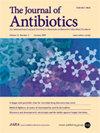Minimum inhibitory concentrations of aztreonam–avibactam, ceftazidime–avibactam and meropenem in clinical isolates of Klebsiella pneumoniae harboring carbapenemase genes
IF 2.1
4区 医学
Q3 BIOTECHNOLOGY & APPLIED MICROBIOLOGY
引用次数: 0
Abstract
This study was aimed at understanding the distributions of the MICs (minimum inhibitory concentrations) of aztreonam–avibactam, ceftazidime–avibactam and meropenem with respect to Klebsiella pneumoniae isolates producing different types of carbapenemases and their combinations. K. pneumoniae isolates were collected between 2019 and 2022 from 37 hospitals. PCR was used to screen for blaKPC-, blaNDM- and blaOXA-48-like genes. MICs were determined by the broth microdilution method for meropenem, aztreonam–avibactam and ceftazidime–avibactam at a constant avibactam concentration of 4 mg l−1. MIC distributions were analyzed for groups of isolates based on the identified carbapenemases including their combinations. The AZT/AVI MIC50 and MIC90 for all NDM-positive isolates were 0.25 and 0.5, respectively, and for serine-carbapenemase-only producers, they were 0.25 and 1 mg l−1, respectively. The CZD/AVI MIC50 and MIC90 values for serine-carbapenemase-only producers were 1 and 4 mg l−1, respectively. The AZT/AVI MIC50 and MIC90 values for co-producers and single carbapenemase producers were the same (i.e., 0.25 and 1 mg l−1, respectively). The total proportion of meropenem-susceptible isolates (≤8 mg l−1) among all the carbapenemase producers was 25.1% (31.1% among single-carbapenemase producers and 9.2% among co-producers). The results support the use of aztreonam–avibactam for the empirical treatment of infections caused by any carbapenemase producers.携带碳青霉烯酶基因的肺炎克雷伯菌临床分离物中阿曲南类-阿维菌素、头孢唑肟类-阿维菌素和美罗培南的最小抑菌浓度。
本研究旨在了解产生不同类型碳青霉烯酶的肺炎克雷伯菌分离株与阿曲南-阿维菌素、头孢唑肟-阿维菌素和美罗培南及其组合的MICs(最低抑菌浓度)的分布情况。肺炎克雷伯菌分离株是在 2019 年至 2022 年期间从 37 家医院采集的。利用 PCR 筛选 blaKPC、blaNDM 和 blaOXA-48 类基因。在阿维菌素浓度为 4 毫克/升的恒定条件下,采用肉汤微量稀释法测定美罗培南、阿曲南-阿维菌素和头孢唑肟-阿维菌素的 MIC。根据已确定的碳青霉烯酶(包括其组合)分析了各组分离菌的 MIC 分布。所有 NDM 阳性分离菌株的 AZT/AVI MIC50 和 MIC90 分别为 0.25 和 0.5,仅产生丝氨酸碳青霉烯酶的分离菌株的 MIC50 和 MIC90 分别为 0.25 和 1 mg l-1。仅产生丝氨酸碳青霉烯酶的菌株的 CZD/AVI MIC50 和 MIC90 值分别为 1 和 4 毫克升-1。共同生产者和单一碳青霉烯酶生产者的 AZT/AVI MIC50 和 MIC90 值相同(即分别为 0.25 和 1 毫克升-1)。在所有碳青霉烯酶生产者中,对美罗培南敏感的分离物(≤8 毫克升-1)的总比例为 25.1%(单碳青霉烯酶生产者为 31.1%,联合生产者为 9.2%)。研究结果支持将阿曲南胺-阿维巴坦用于任何碳青霉烯酶生产者引起的感染的经验性治疗。
本文章由计算机程序翻译,如有差异,请以英文原文为准。
求助全文
约1分钟内获得全文
求助全文
来源期刊

Journal of Antibiotics
医学-免疫学
CiteScore
6.60
自引率
3.00%
发文量
87
审稿时长
1 months
期刊介绍:
The Journal of Antibiotics seeks to promote research on antibiotics and related types of biologically active substances and publishes Articles, Review Articles, Brief Communication, Correspondence and other specially commissioned reports. The Journal of Antibiotics accepts papers on biochemical, chemical, microbiological and pharmacological studies. However, studies regarding human therapy do not fall under the journal’s scope. Contributions regarding recently discovered antibiotics and biologically active microbial products are particularly encouraged. Topics of particular interest within the journal''s scope include, but are not limited to, those listed below:
Discovery of new antibiotics and related types of biologically active substances
Production, isolation, characterization, structural elucidation, chemical synthesis and derivatization, biological activities, mechanisms of action, and structure-activity relationships of antibiotics and related types of biologically active substances
Biosynthesis, bioconversion, taxonomy and genetic studies on producing microorganisms, as well as improvement of production of antibiotics and related types of biologically active substances
Novel physical, chemical, biochemical, microbiological or pharmacological methods for detection, assay, determination, structural elucidation and evaluation of antibiotics and related types of biologically active substances
Newly found properties, mechanisms of action and resistance-development of antibiotics and related types of biologically active substances.
 求助内容:
求助内容: 应助结果提醒方式:
应助结果提醒方式:


